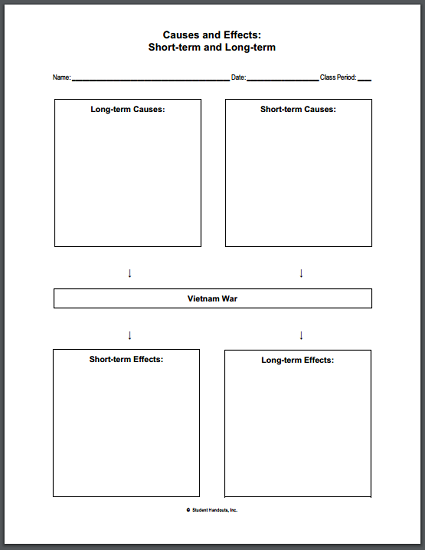| Causes and Effects of the Vietnam War DIY Infographic Worksheet |
|---|
| www.studenthandouts.com > U.S. History > Decades of Change > Worksheets |
 |  |
|---|
| Students chart the long- and short-term causes and effects of the Vietnam War on this DIY infographic. Click here to print (PDF file). Answers will vary. |
|---|
|
The Vietnam War was a complex conflict with numerous long- and short-term causes and effects. Long-Term Causes: Colonial History: Vietnam's history of French colonialism created a backdrop of resistance and nationalism. The struggle for independence led to tensions between Vietnamese nationalists and colonial powers. Rise of communism: The global spread of communism and the ideological battle of the Cold War set the stage for U.S. involvement. The fear of a "domino effect" in Southeast Asia drove American foreign policy. Vietnamese Nationalism: Ho Chi Minh and the Viet Minh fought for Vietnamese independence from the French, which culminated in the First Indochina War (1946-1954). The Geneva Accords temporarily divided Vietnam at the 17th parallel. Cold War Dynamics: The Cold War rivalry between the United States and the Soviet Union created a context in which both superpowers sought to expand their influence. The U.S. aimed to contain communism, while the USSR and China supported communist movements. Short-Term Causes: Geneva Accords (1954): The agreement temporarily divided Vietnam into North Vietnam (communist) and South Vietnam (anti-communist), with plans for reunification elections that never occurred. This division set the stage for conflict. Political Instability in South Vietnam: The South Vietnamese government, led by Ngo Dinh Diem, was corrupt and unpopular. Diem's repressive policies and refusal to hold reunification elections fueled insurgency. Gulf of Tonkin Incident (1964): Alleged attacks on U.S. ships by North Vietnamese forces led to the Gulf of Tonkin Resolution, which granted President Lyndon B. Johnson broad military powers in Vietnam, leading to escalated U.S. involvement. Short-Term Effects: Escalation of U.S. Involvement: The U.S. deployed large numbers of troops and resources, significantly escalating the conflict. This included extensive bombing campaigns and ground operations. Anti-War Movement: As the war dragged on, anti-war sentiment grew in the United States, leading to widespread protests and social unrest. The movement was driven by high casualty rates, media coverage, and ethical concerns. Political Changes: The war deeply affected U.S. politics, contributing to President Johnson's decision not to seek re-election and influencing subsequent administrations' policies. Richard Nixon's policy of "Vietnamization" aimed to transfer combat roles to the South Vietnamese. Long-Term Effects: Human and Economic Costs: The war caused significant loss of life, with millions of Vietnamese and over 58,000 American soldiers killed. The economic costs were enormous, impacting both U.S. and Vietnamese economies for years. Impact on Vietnam: Vietnam suffered massive destruction and disruption. After the war, the country faced severe economic challenges and isolation. The reunification under communist control led to political purges and reeducation camps. U.S. Foreign Policy: The Vietnam War led to a more cautious approach to military intervention, known as the "Vietnam Syndrome." It influenced U.S. policies in subsequent conflicts and fostered skepticism towards government and military leaders. Social and Cultural Impact: The war deeply affected American society, contributing to a sense of disillusionment and division. It inspired a vast body of literature, film, and music that reflected the complex experiences and emotions of the era. Veterans' Issues: Returning veterans faced significant challenges, including physical injuries, psychological trauma, and societal reintegration difficulties. The war highlighted the need for better veteran care and support. Regional Effects: The war had significant impacts on neighboring countries, particularly Cambodia and Laos, where bombings and subsequent conflicts led to further instability and tragedy, such as the rise of the Khmer Rouge in Cambodia. In summary, the Vietnam War was driven by deep-rooted historical, ideological, and political causes. Its effects were far-reaching, reshaping the lives of millions, altering U.S. foreign policy, and leaving a lasting legacy on both American and Vietnamese societies. |
| www.studenthandouts.com > U.S. History > Decades of Change > Worksheets |









